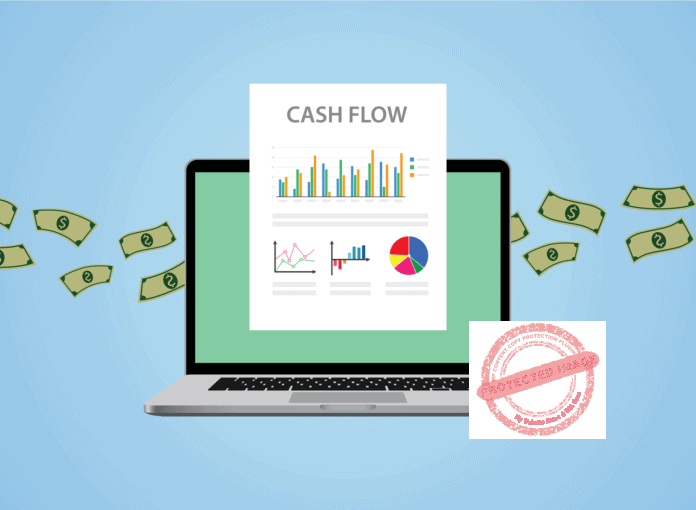Do you want to know how to improve cash flow in a business ?
It’s no secret that cash flow is key to the success of any business.
When money comes in regularly and consistently, the business can afford to invest in growth and expansion.
However, when cash flow is tight or inconsistent, it can be challenging to make ends meet.
Here in this post, we will discuss how you can improve your company’s cash flow and ensure a healthy future for your business.
Understand What Cash Flow Is
The first step to improving your business’s cash flow is understanding what it is.
Your Cash flow is the money that comes in and out of your business daily.
Several factors can affect it, including sales, expenses, investments, and loans.
To calculate your company’s cash flow, you will need to track your income and expenses for a period of time.
This is another way of saying track the money going into your business and coming out of your business.
This will give you a good view of where your money is coming from and going.
Once you have a good and clear understanding of your cash flow, you can look for ways to improve it.
The Difference Between Cash Flow And Revenue
Revenue is not the same as cash flow.
Revenue is the total amount of money that a company earns in a given period of time, while cash flow is the amount of money that a company has available to pay its bills.
Revenue does not always equal cash flow.
Some businesses have expenses that must be paid even before receiving payment for the revenue they have earned for their products or services.
For example, if a company sells a product on credit, the revenue from the sale will be recorded when the product is sold, but the cash flow will not occur until the customer pays the invoice.
You may have a great business, however, you will eventually run into trouble if your cash flow is poor.
The Difference Between Cash Flow And Profit
It might be news to you to learn that there is a big difference between profit and cash flow.
Profit is the total revenue that your business brings in minus the expenses associated with running the business.
On the other hand, your cash flow is the actual movement of money in and out of your business.
Profit is significant because it’s a measure of how much your business is making.
But cash flow is crucial because it’s a measure of how much money your business has on hand to pay its bills.
What is Positive Cashflow
Positive cash flow is when a company’s cash inflows exceed its outflows.
This can happen for various reasons, but it typically occurs when a company is growing and bringing in more revenue than it is spending.
Other reasons that cause positive cashflow include reducing expenses, increasing prices, or delaying payments.
Positive cash flow is crucial because it allows a company to have the money to pay its bills, expand its operations, and make investments.
It also allows companies to avoid taking on debt or selling equity to raise capital.
What is Negative Cash flow?
Negative cash flow is when a company’s cash inflows are less than its cash outflows.
While it is possible to survive with negative cash flow for a short period of time, it is not sustainable in the long term and will eventually lead to the business’s demise.
Reasons that cause negative cash flow include:
– Not enough sales: This is the most common cause of negative cash flow. If a business doesn’t have enough sales, it will struggle to pay its bills and stay afloat.
– Too much inventory: If a company has too much inventory, it will tie up valuable resources that could be used elsewhere. This can lead to cash flow problems down the road.
– High operating expenses: If a company’s operating expenses are too high, it will eat into its profits and make it difficult to pay its bills. This can be caused by various factors, such as inefficient processes, excessive overhead, or bad management.
Why is Tracking Cashflow Important?
Cash flow is the life-force of any business.
It allows your business to pay its bills, invest in new opportunities, and grow.
That’s why it’s so vital to track your cash flow—you need to know where your money is coming from and where it’s going.
Tracking cash flow can give you insights into whether or not your business is generating enough revenue to cover its expenses.
Additionally, tracking cash flow can help you identify potential problems early on so that you can take some steps to fix them before they become too large to manage.
Furthermore, tracking cash flow can help you make better decisions about where to allocate your resources.
If you know how much money is coming in and going out, you can decide what to spend your money on and what to cut back on.
Ultimately, tracking cash flow is important because it gives you a clear picture of the financial health of your business.
This information can be critical in making decisions about your company’s future.
How To Improve Cash Flow In A Business – Track Cashflow in Your Business
There are several ways to track cash flow.
The most crucial thing is to find a method that works for you and your business.
Whatever means you choose, make sure that it is one that you are comfortable with, and that will give you the knowledge you need to make informed decisions about your business.
There are a few different ways to track cash flow.
You can do it manually by using a spreadsheet, or you can use accounting software.
If you track your cash flow manually, you’ll need to keep careful records of your income and expenses.
This can be time-consuming, but it’s essential to be accurate.
Using a spreadsheet is an excellent way to track your cash flow if you’re comfortable with spreadsheets and formulas.
You can find spreadsheet templates on the internet to help you get started.
Accounting software is the easiest way to track cash flow.
Most accounting software programs will allow you to connect your bank and credit card accounts, so all your transactions will be automatically downloaded.
This can also save you a lot of time and hassle.
Once you start tracking your cash flow, you’ll see where your money is coming from and going.
This information can be beneficial in identifying areas where you can improve your cash flow.
There are a number of key things to look for when you’re tracking your cash flow:
– How much money is coming in?
– How much money is going out?
– When are the peaks and troughs in your cash flow?
– What are your most significant expenses?
You may also want to consider hiring an accountant to help you track your cash flow.
Once you have a good understanding of your cash flow, you can start to look for ways to improve it.
How To Improve Cash Flow In A Business – Make A Budget And Stick To It
One of the most efficient ways to boost cash flow in a business is to make a budget and stick to it.
This may sometimes seem like common sense, but many businesses don’t have a budget, or if they do, they don’t stick to it.
A budget will help you track your income and expenses so that you can see where your money is going.
It will also help you make the relevant adjustments to ensure that your spending aligns with your goals and objectives.
So how do you budget to improve your cash flow.
You’ll need to track your income and expenses, both fixed and variable.
Your fixed costs are things like rent or mortgage payments, while your variable costs are things like inventory or marketing.
Once you have a clear grasp of where your money is going, you can make adjustments.
When you have a budget and track it, you have a plan for your money and you review you spending against that plan.
There are many ways to approach creating a budget.
You can use software like Quickbooks or Mint or simply create a spreadsheet in Excel.
Negotiate With Your Suppliers for Better Prices or Payment Terms
One way to improve your business’s cash flow is to renegotiate better payment terms with your suppliers.
This could involve asking for a discount on the products or services you purchase from them or negotiating longer payment terms to have more time to pay off your invoices.
If you have a good business relationship with your suppliers, they may be willing to work together with you to help improve your business cash flow situation.
Another option is to purchase your inventory from wholesalers or suppliers who offer more favorable payment terms than your current suppliers.
This could help you reduce the amount of money you need to front for inventory and free up some cash flow in the short term.
Invest in Accounts Receivable Financing
Another option for improving your business’s cash flow is to invest in accounts receivable financing.
Accounts receivable financing allows you to sell your invoices at a discount in exchange for immediate payment.
While you will lose out on some of the money you are owed, you will receive the rest of the money upfront, which can help with short-term cash flow needs.
Many different companies offer accounts receivable financing, so shop thoroughly for the best rates and terms.
Offer Discounts for Early Payment
If your invoices have payment terms of 30 days or more, you may want to consider offering discounts for early payment.
This could involve giving a small percentage off the total invoice if paid within a certain number of days.
For example, you could offer two percent discount if the invoice is paid within seven days.
While this will reduce the amount of money that you are ultimately paid, it can help improve your cash flow in the short term.
Additionally, many customers are more likely to pay an invoice if they know they will receive a discount.
Consider Getting A Business Loan
To boost and improve your cash flow, you may want to consider getting a business loan.
There are many types of business loans available, so be sure to shop around and compare the rates and terms of the loan before you decide.
Getting a business loan can help improve your cash flow by giving you access to the funds that you need to cover expenses.
However, it is essential to remember that you will need to repay the loan, plus interest, so be sure that you can afford the payments before you take out a loan.
How To Improve Cash Flow In A Business – Minimize Waste
One way to ensure a positive cash flow for your business is to minimize waste.
Take a look at your production process and see where you can reduce waste without affecting quality.
Are there any surplus materials or supplies that you can eliminate?
Do you have any outdated equipment costing you more to maintain than it’s worth?
Do you have any processes that are needlessly complicated or time-consuming?
Even small changes can make a big difference in your cash flow.
Are you buying inventory that you don’t need?
For example, if you’re able to reduce your inventory by just five percent, that can free up a significant amount of working capital.
And if you’re able to streamline your production process so that it’s just five percent faster, that can also have a significant impact on your bottom line.
Of course, you don’t want to sacrifice quality in the name of efficiency.
But if you can find ways to do things better, faster, and cheaper, it will pay off in improved cash flow.
Reduce Expenses
In addition to minimizing waste, you can also improve your cash flow by reducing your expenses.
Take a close look at your business budget and see where you can cut back.
Are there any areas where you’re spending more than you need to?
Are there any unnecessary luxuries that you can do without?
Remember, every dollar you save is one less that you have to generate in revenue.
So even small cuts can make a big difference in your cash flow.
Options for reducing expenses include
– cutting back on unnecessary costs
– renegotiating contracts with suppliers or vendors
– downsizing your office space
– reducing or eliminating employee perks
– and cutting back on advertising and marketing expenses.
While it may not be easy, reducing your expenses can significantly impact your cash flow.
Increase Prices And Add Value To Your Offerings
If you’re struggling with cash flow, an option to increase cash flow is to raise prices in order to boost your bottom line.
However, this might backfire, though it could also be successful.
If you’re selling a product or service, you should consider increasing your prices.
This will require some market research to ensure that you don’t price yourself out of the market, but if you can find a way to charge more for your product or service, it will directly impact your cash flow.
You could also focus on finding ways to increase the value of your product or service.
Can you add any additional features or benefits to make your offering more attractive to customers?
Can you improve the quality of your product or service so that customers are willing to pay a higher price?
If you can find ways to increase the value of your offering, you’ll be in a much better position to improve your cash flow.
You can add value to your offerings by bundling them together or adding additional features or services.
For example, if you’re selling a software program, you could offer training as an add-on service to the training.
In addition, if you are selling a physical product, you could add a warranty or service plan.
By adding value to your offerings, you can justify charging more, which will improve your cash flow.
Review your pricing strategy and make sure you are not leaving money on the table.
How To Improve Cash Flow In A Business – Track Inventory Levels
One way to improve your cash flow is to keep a close eye on your inventory levels.
If you have too much inventory, it ties up a lot of cash that could be used for other purposes.
You don’t want to stock up inventory that may not sell for months or years.
On the other hand, if you don’t have enough inventory, you could miss out on sales opportunities.
Tracking inventory levels will help you anticipate how much money you need on hand to pay for inventory.
By tracking inventory levels, you can also avoid having too much or too little inventory on hand, which can tie up cash unnecessarily.
Ensure you’re not overordering supplies or products or paying for services you don’t need.
Increase Productivity
Another way to improve cash flow is to increase productivity. This could mean several things, such as:
-Improving your manufacturing process so you can produce more products in less time
– automating tasks or processes to save time
– outsourcing tasks that are taking up too much of your time
– ensuring that employees are working efficiently and that processes are streamlined.
By increasing productivity, you can free up time and money that can be used to improve cash flow.
Have An Efficient Billing and Receiving Process
One more way to improve your business’s cash flow is to have an efficient billing process.
This means creating invoices as soon as products or services are provided and quickly following up on overdue invoices.
You can use software to automate your billing process and make it easier to keep track of payments.
In addition, make sure you’re clear about your payment terms with customers, so there are no surprises.
Invest in technology that will help automate some of your financial processes
This could include software that automates accounts payable and receivable or a customer relationship management system.
Delay Payments Where Possible, Or Pay Early For Discounts
Some businesses can offer their customers a discount for paying early.
This can help improve your cash flow by bringing in money sooner.
Other businesses may be willing to delay payment if it means keeping a good customer.
Either way, it is worth considering what options are available to you in terms of payments.
Utilize Business Credit Cards And Lines Of Credit To Help With Cash Flow
If you have a business credit card or line of credit, you can use it to help with cash flow.
This can be an excellent way to tide your business over during tough times.
Just make sure that you can make the payments on time, as missed payments can damage your credit score.
These can be used to cover expenses when cash is tight.
Just be sure to pay off the balances in full each month to avoid paying interest.
Improve Customer Service To Help Improve Cash Flow In Your Business
Improving your customer service is another excellent way to improve your cash flow.
If customers are happy with the product or service they receive, they’re more likely to pay on time and in full.
Happy customers are also more likely to become repeat customers and refer others to your business.
So, what is it you can do to improve your customer service?
Here are a few ideas:
– Make it easy for customers to reach you. Have a customer service number they can call, and make sure someone is available to answer calls during business hours.
– Train your staff on how to handle customer inquiries and complaints.
– Respond to customer inquiries and complaints promptly.
– Follow up with customers after they’ve made a purchase to ensure they’re satisfied.
– Get feedback from customers regularly and use it to improve your products or services.
By making your customer service better, you can improve your cash flow.
How To Improve Cash Flow In A Business – Plan for Slow Times
Make sure you have a backup plan for when sales are slow.
Every business has slow times, and it’s essential to have a plan for when sales are slow.
This could include cutting back on expenses, offering discounts or promotions, or increasing marketing efforts.
Having a plan in place can help improve your cash flow during slow periods.
Invest In Assets That Will Generate Revenue
If you want to boost your business’s cash flow, one of the best things you can do is invest in assets that will generate revenue.
This could include anything from commercial real estate to picking stocks to software and equipment that could be used to generate income.
By investing in these types of assets, you can bring in more money, which can help improve your cash flow.
How To Improve Cash Flow In A Business – Conclusion
There are several things you can do to improve your business’s cash flow.
By following the tips discussed above, you work on ensuring that your business has the cash it needs to thrive.
Good luck with your journey.









